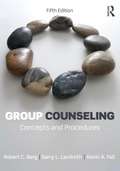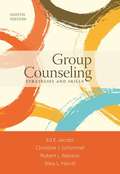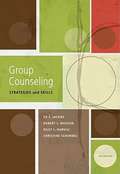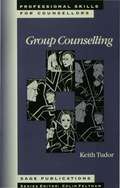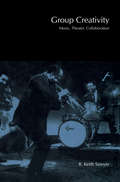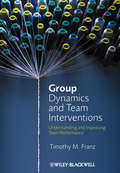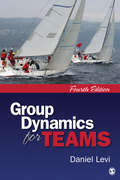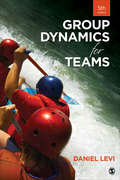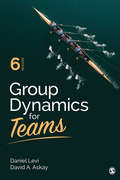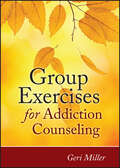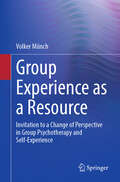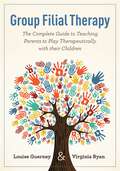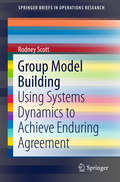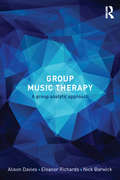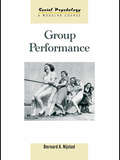- Table View
- List View
Group Counseling: Concepts and Procedures (Fifth Edition)
by Robert C. Berg Garry L. Landreth Kevin A. FallFirst published in 1979, Group Counseling has consistently been a widely used and praised text, providing both novice and experienced counselors with a framework from which to expand their group counseling skills and knowledge. This fifth edition has been thoroughly revised and updated to reflect the newest work in the field, the 2009 CACREP standards, and the Association for Specialists in Group Work practice standards. As in the previous editions, the authors draw upon their extensive experience and share their own styles of leading groups as a personal and practical way to illustrate the differences in group leadership. Berg, Landreth, and Fall present a thorough discussion of the rationale for using group counseling with an emphasis on the group's role as a preventive environment and as a setting for self-discovery. The authors examine the group facilitator's internal frame of reference and ways to overcome of initial anxiety about leading groups, and they also explore typical problems in the development, facilitation, and termination of the group process and provide suggested solutions. Application of group counseling is considered with children, adolescents, adults, as well as with special populations, such as abused children, juvenile offenders, and individuals with emotional difficulties. A helpful glossary of group counseling terminology provides a quick reference source for important terms. New to this edition are a chapter on diversity and social justice in group work an expanded chapter on co-leadership, a topic often ignored in other group counseling texts separate chapters on group work with children and group work with adolescents so that reader can focus more easily on the unique aspects of working with each population a chapter on evaluating groups at the leader, group, and individual member levels. A collection of supplemental resources is available online to benefit both instructors and students. Instructors will find PowerPoint slides and test banks to aid in conducting their courses, and students can access questions for thought and reflection to supplement their review of the chapters in the text. These materials can be accessed at www. routledgementalhealth. com/cw/Berg
Group Counseling: Process And Technique
by Kevin A. FallThe subtleties of counseling are very difficult to accurately express in written form alone. This is particularly true in the case of group work, where the interpersonal dynamics expand geometrically. A good group counseling textbook, such as the fifth edition of Group Counseling: Concepts and Procedures (2013), can provide a solid foundation, but video demonstrations can illustrate the nuances of the group experience in ways that words alone cannot. To provide just such a video, Kevin A. Fall has filmed a series of segments of a group in which he acts as leader with six participants and demonstrates the stages of a group as it moves from first session through termination. Fall offers regular sections of audio commentary, analysis, and processing on each segment, totaling a 120-minute program. The companion workbook provides additional information to fill in what is not shown on the film and includes exercises, activities, and discussion questions related to each video segment. The video and workbook are designed to work seamlessly with the Berg, Landreth, and Fall text, but they can also be used alongside any other group counseling textbook.
Group Counseling: Process and Technique
by Kevin A. FallThe subtleties of counseling are very difficult to accurately express in written form alone. This is particularly true in the case of group work, where the interpersonal dynamics expand geometrically. A good group counseling textbook, such as the fifth edition of Group Counseling: Concepts and Procedures (2013), can provide a solid foundation, but video demonstrations can illustrate the nuances of the group experience in ways that words alone cannot. To provide just such a video, Kevin A. Fall has filmed a series of segments of a group in which he acts as leader with six participants and demonstrates the stages of a group as it moves from first session through termination. Fall offers regular sections of audio commentary, analysis, and processing on each segment, totaling a 120-minute program. The companion workbook provides additional information to fill in what is not shown on the film and includes exercises, activities, and discussion questions related to each video segment. The video and workbook are designed to work seamlessly with the Berg, Landreth, and Fall text, but they can also be used alongside any other group counseling textbook.
Group Counseling: Strategies and Skills
by Christine J. Schimmel Ed Jacobs Bob Masson Riley HarvillGroup Counseling: Strategies and Skills provides readers with a comprehensive exploration of group counseling with emphasis on critical techniques for effective group leadership. <p><p>The text is known for being hands-on and reader friendly. It successfully marries traditional theories and concepts with valuable strategies and sage advice that prepares group leaders for impactful practice. Readers also receive access to videos that show leaders demonstrating the skills discussed in the book. <p><p>The ninth edition features new content related to the social justice movement as well as leading groups during times of crisis such as the global pandemic that began in 2020. Each chapter has been updated to include learning objectives, information on leading groups virtually, and case studies. The section about leading groups of children and adolescents has been expanded, and references throughout the text have been updated. <p><p>Group Counseling is an indispensable resource for practicing or future counselors, social workers, psychologists, and others who currently lead or are preparing to lead groups in a variety of settings.
Group Counseling: Strategies and Skills (Eighth Edition)
by Ed E. Jacobs Robert L. L. Masson Riley L. Harvill Christine J. SchimmelGROUP COUNSELING: STRATEGIES AND SKILLS, Eighth Edition, provides an in-depth look at group counseling with an emphasis on practical knowledge and techniques for effective group leadership. The authors discuss the many facets of group counseling and provide examples of how each skill can be applied in a wide range of group settings to produce effective and efficient group sessions. The book's active approach focuses on the skills necessary for starting and ending a session, as well as on how to make the middle phase productive and meaningful. Through its integration of traditional theories and concepts of group process with thoughtful strategies and specific skills, this reader-friendly book meets the needs of practicing or future counselors, social workers, psychologists, and others who are leading or preparing to lead groups in a variety of settings.
Group Counseling: Strategies and Skills (Seventh Edition)
by Ed E. Jacobs Robert L. L. Masson Riley L. Harvill Christine J. SchimmelThis widely used and respected book presents an active, multisensory approach to group leading, focusing heavily on group leadership skills. While written with the counselor in mind, GROUP COUNSELING: STRATEGIES AND SKILLS, 7th Edition also provides an outstanding discussion of group dynamics for professionals in group leadership positions. The authors discuss the many facets of group counseling and provide examples that show how each skill can be applied in a wide range of group settings to produce efficient working groups.
Group Counselling (Professional Skills for Counsellors Series)
by Mr Keith Tudor`Group Counselling is an exceptionally practical and useful guide for anyone involved, or anticipating involvement, in groupwork' - Clive Lloyd, Therapeutic Communities This book provides a comprehensive examination of theories and concepts relating to group counselling and shows how differing theoretical frameworks can be used as a basis for practice. Organized around the counselling process, the book considers the practicalities of establishing and running a group, raising awareness of its life cycle, its cultural location and many other diverse issues. Special emphasis is placed on the importance of therapeutic attitudes and philosophies as a basis for practice, and humanistic and existential approaches to group counselling are given particular attention. The author encourages readers to be aware of their conceptual framework and how it influences their work.
Group Creativity: Music, Theater, Collaboration
by R. Keith SawyerGroup Creativity explores the unique form of creativity that emerges from collaborating groups. Dr. Sawyer draws on his studies of jazz ensembles and improvisational theater groups to develop a model of creative group processes. He applies this model of group creativity to a wide range of collaborating groups, including group learning in classrooms and innovative teams in organizations. In group creativity, a group comes together to collaboratively create in real time. The creative inspiration emerges from the interaction and communication among the members, and makes the result more than the sum of its parts. The dynamic, moment-to-moment communication among jazz musicians and improvising actors is the primary topic of the book. Sawyer explores performers' close listening and sensitivity, the submerging of the ego to the group mind, and the ways that performers work together to create something better than and different from what one solitary individual could create alone. These explorations provide insight into all forms of group creativity and collaboration.
Group Dynamics In Occupational Therapy: The Theoretical Basis and Practice Application of Group Intervention
by Marilyn ColeThe theory section clarifies how occupation based models and frames of reference change the way occupational therapy groups are organized and how theory impacts the selection of group activities, goals, and outcomes. Recent examples and evidence are added in this Fifth Edition to reflect the design and use of groups for evaluation and intervention within the newly evolving paradigm of occupational therapy.
Group Dynamics and Team Interventions
by Timothy M. FranzStrong teams can be one of the greatest strengths of an organization-just as poor teams can spell disaster. Group Dynamics and Team Interventions brings research and practice together to offer proven application and intervention techniques to help optimize team functioning in the workplace. A benefit to academics and practitioners alike, this book provides readers with a better understanding of the dynamics that inform team behavior, along with assessment tools and practical techniques to create and maintain high-performing teams.
Group Dynamics for Teams
by Daniel LeviGrounded in psychology research but with a practical focus on organizational behavior issues, Group Dynamics for Teams helps readers understand and participate in teams more effectively in day-to-day work. Best-selling author Daniel Levi and new co-author David A. Askay thoroughly examine basic group dynamics concepts, such as goals, norms, cooperation, and communication, as well as review the main challenges that teams face, such as conflict, decision making, problem solving, creativity, and valuing diversity. Throughout the book are discussions of the organizational context of teams, including the impacts of organizational culture, virtual teamwork, rewarding teams, and team building.
Group Dynamics for Teams: Levi, Group Dynamics For Teams
by Daniel J. LeviIncorporating the latest research throughout, Daniel Levi’s Fifth Edition of Group Dynamics for Teams explains the basic psychological concepts of group dynamics, focusing on their application with teams in the workplace. Grounded in psychology research and a practical focus on organizational behavior issues, this engaging book helps readers understand and more effectively participate in teams.
Group Dynamics for Teams: Levi, Group Dynamics For Teams 3e + Cobb, Leading Project Teams
by Daniel J. LeviIncorporating the latest research throughout, Daniel Levi’s Fifth Edition of Group Dynamics for Teams explains the basic psychological concepts of group dynamics, focusing on their application with teams in the workplace. Grounded in psychology research and a practical focus on organizational behavior issues, this engaging book helps readers understand and more effectively participate in teams.
Group Dynamics for Teams: Levi, Group Dynamics For Teams 3e + Cobb, Leading Project Teams
by Daniel J. Levi Dr. David A. AskayGrounded in psychology research but with a practical focus on organizational behavior issues, Group Dynamics for Teams helps readers understand and participate in teams more effectively in day-to-day work. Best-selling author Daniel Levi and new co-author David A. Askay thoroughly examine basic group dynamics concepts, such as goals, norms, cooperation, and communication, as well as review the main challenges that teams face, such as conflict, decision making, problem solving, creativity, and valuing diversity. Throughout the book are discussions of the organizational context of teams, including the impacts of organizational culture, virtual teamwork, rewarding teams, and team building.
Group Dynamics for Teams: Levi, Group Dynamics For Teams 3e + Cobb, Leading Project Teams
by Daniel J. Levi Dr. David A. AskayGrounded in psychology research but with a practical focus on organizational behavior issues, Group Dynamics for Teams helps readers understand and participate in teams more effectively in day-to-day work. Best-selling author Daniel Levi and new co-author David A. Askay thoroughly examine basic group dynamics concepts, such as goals, norms, cooperation, and communication, as well as review the main challenges that teams face, such as conflict, decision making, problem solving, creativity, and valuing diversity. Throughout the book are discussions of the organizational context of teams, including the impacts of organizational culture, virtual teamwork, rewarding teams, and team building.
Group Dynamics in Exercise and Sport Psychology: Contemporary Themes
by Mark R. Beauchamp Mark A. EysCan a better understanding of group dynamics raise individual and team athletic performance or improve the outcomes of exercise interventions? Much human behaviour in sport and exercise settings is embedded within groups, where individuals’ cognitions, emotions, and behaviours influence and are influenced by other group members. Now in a fully revised, updated, and expanded second edition, Group Dynamics in Exercise and Sport Psychology explores the unique psychological dynamics that emerge in sport and exercise groups. It provides a clear and thorough guide to contemporary theory, research, and applied practice, covering core themes and cutting-edge topics as well as highlighting directions for future research. The book is organised into five thematic sections: Part 1: The Self in Groups Part 2: Leadership in Groups Part 3: Group Environment Part 4: Motivation in Groups Part 5: Socio-Environmental Issues in Groups This new edition includes seven completely new chapters, exploring important emerging issues such as social identity, the family, co-ordination and shared knowledge within sport teams, the group as a vehicle for facilitating individual behavior change, social support and emotion regulation, peer leadership, and cultural perspectives in relation to group dynamics. No other book on group dynamics in sport or exercise offers such a close examination of the evidence base, and therefore Group Dynamics in Exercise and Sport Psychology is important reading for all students, researchers, or practitioners working in sport or exercise psychology, kinesiology, sport and exercise science, sports coaching, or physical education.
Group Exercises for Addiction Counseling
by Geri MillerAn indispensable collection of ready-to-use, proven exercisesProviding immediately useful group counseling suggestions and tips for addictions counselors, Group Exercises for Addiction Counseling offers powerful techniques that can be adapted to any clinical practice.Written in the author's gentle yet purposeful voice, this reader-friendly resource is filled with guidance for developing an addictions counseling group; handling Stage 2 confrontations of the leader; and building group member awareness. In addition, the author helps counselors enhance client awareness of addiction-related stressors and how to cope with those stressors.Group Exercises for Addiction Counseling contains valuable information on:Addiction recoveryFamily, relationships, and cultureFeelings explorationGroup community buildingRecovery skillsValuesOpening and closing each group sessionFostering care, respect, and honesty in the group counseling setting, the techniques found in Group Exercises for Addiction Counseling allow counselors to help their clients break out of dysfunctional interaction patterns and live better lives.
Group Experience as a Resource: Invitation to a Change of Perspective in Group Psychotherapy and Self-Experience
by Volker MünchThis textbook for psychotherapists and group therapists encourages the reader to reflect on their own group experiences throughout their life journey and to relate these insights to therapy processes. Psychological life and personal development always occur within networks. Analytical group therapy utilizes this and makes psychological processes visible that often remain unclear in individual treatments. Our understanding of human psychological development is transforming in light of neuroscientific findings and against the backdrop of the complex societal challenges of our time, evolving into a view of humans as social animals. We are witnessing a resurgence in group therapy and an openness to theories that emphasize our mutual dependence in a positive sense. Togetherness and solidarity can thus be practiced collectively, unleashing transformative power for change in individuals, but also for society. Many relatable examples, especially from therapeutic groups, illustrate this. Written for: Psychotherapists, group therapists, group leaders in the medical and social fields. About the Author: Dipl. Psych. Volker Münch, Psychological Psychotherapist in private practice in Munich. Teaching analyst, supervisor, and lecturer at MAP, Munich. Publications on topics such as therapeutic attitude, digitalization, and midlife crisis.
Group Filial Therapy: The Complete Guide to Teaching Parents to Play Therapeutically with their Children
by Virginia Ryan Louise GuerneyIn Group Filial Therapy (GFT), therapists train parents to conduct play sessions with their own children to help meet children's therapeutic needs, and to transfer appropriate skills to family life. Based on parents' application of Child-Centred Play Therapy, taught and supervised by filial therapists, this evidence-based method is highly effective for working with families from diverse backgrounds and locations. This book provides an accessible guide to the theory and practice of GFT, and for the first time offers step-by-step guidelines for implementing the GFT program developed by Dr Guerney, the co-creator of Filial Therapy. Important practical considerations are addressed by Dr Guerney and Dr Ryan, such as how to determine the composition of groups and the duration of programs, and how to conduct Filial Therapy intakes. The facilitative attitudes and skills needed to be an effective Filial Therapy group leader are also described, and comprehensive instructions for implementing Dr Guerney's 20-week model of GFT are provided. The book closes with examples of how the program may be adapted to meet the needs of special groups. Replete with examples and dialogues bringing to life the group process, this definitive guide will enable therapists already familiar with the method, as well as those wishing to learn it, to maximise the fulfilment of therapeutic goals for participating families. Practitioners in mental health, social services and counselling, as well as parenting experts, play and filial therapists and therapists in training will find that this book expands and enriches the services they can offer their clients.
Group Integration and Multiculturalism
by Dan PfefferWith immigration fulfilling the role of population maintenance and growth in many Western democracies, how should these countries incorporate newcomers? This book argues that states ought to promote group integration for communities that have settled through immigration. Pfeffer defines group integration as the process through which communities develop lobbies and institutions that represent the group's perspective, and help it to enter into dialogue with their receiving society. With examples from throughout Europe and North America, the justice-based argument suggests that states should facilitate group integration since it improves, among other things, the democratic participation of groups.
Group Interactive Art Therapy: Its use in training and treatment
by Diane WallerThe first edition of Group Interactive Art Therapy presented the first theoretical formation of a model integrating the change-enhancing factors of both interactive group psychotherapy and art therapy, demonstrating its use in practice through a series of illustrated case examples. This long-awaited second edition updates the content of the original in light of the major social, cultural and political changes of the past two decades and presents new examples of the model in practice. The new edition includes a brand-new section on the use of group interactive art therapy in research with people with dementia, with schizophrenia, and those in rehabilitation from a stroke. The book also features two chapters on the use of the model in a broader context. The book is presented in four parts: Introducing group interactive art therapy The model in practice: case examples The wider context Group interactive art therapy used in research Each section demonstrates the flexibility and adaptability of the model in different cultural and social settings and with a variety of client groups. The development of knowledge about the skills required for conducting an interactive art therapy group and its suitability for different clients has been incorporated throughout the book, as well as practical information on working in areas where there is limited access to art materials.
Group Interventions in Schools: A Guide for Practitioners
by Dana Marchese Jennifer P. Keperling Nicholas Ialongo Wendy M. ReinkeNumerous group interventions have been shown to be effective for helping K-8 students who are struggling with--or at risk for--a wide range of mental health and behavior problems. This unique book gives school practitioners indispensable tools for making any evidence-based group intervention more successful. It addresses the real-world implementation challenges that many manuals overlook, such as how to engage children and parents and sustain their participation, manage behavior in groups, and troubleshoot crisis situations. User-friendly features include case examples, reflection questions, role-play scenarios, and 31 reproducible forms and handouts; the print book has a large-size format with lay-flat binding for easy photocopying. Purchasers get access to a Web page where they can download and print the reproducible materials. This book is in The Guilford Practical Intervention in the Schools Series.
Group Model Building: Using Systems Dynamics to Achieve Enduring Agreement (SpringerBriefs in Operations Research)
by Rodney ScottThis book describes the cognitive and interpersonal effects of group model building, and presents empirical research on what group model building achieves and how. Further, it proposes an integrated causal mechanism for the effects on participants. There have been multiple previous attempts at explaining the effects of group model building on participants, and this book integrates these various theories for the first time.The causal mechanisms described here suggest a variety of design elements that should be included in group model building practice. For example, practitioners typically try to reduce complexity for clients, to make the process feel more accessible. In contrast, the findings presented here suggest that the very act of muddling through complexity increases participants’ affective commitment to the group and the decisions made.The book also describes implications for theory and practice. System dynamics has traditionally been interested in using technical modeling processes to make policy recommendations. Group model building demonstrates that these same techniques also have implications for group decision making as a method for negotiating agreement. The book argues for the value of group model building as a mediating or negotiating tool, rather than merely a positivist tool for technical problems.
Group Music Therapy: A group analytic approach
by Alison Davies Eleanor Richards Nick BarwickIn Group Music Therapy Alison Davies, Eleanor Richards and Nick Barwick bring together developments in theory and clinical practice in music therapy group work, celebrating the richness of what group analytic thinking and music therapy can offer one another. The book explores the dynamic elements of the processes that take place in both group analytic therapy and group music therapy, exploring both the commonalities and the distinctive characteristics of the two modalities. To music therapists, psychotherapists and other arts therapists Group Music Therapy offers a body of knowledge and enquiry through which to understand the music therapy group process through some of the central proposals of group analysis; to group analysts it offers insight into the possibilities of non-verbal communication through improvised music and, more widely, invites thought in musical terms about the nature of events and exchanges in a therapy group. Links are made with group analytic theory as well as with other associated theoretical traditions, such as attachment theory and theories of early infant development. The book explores the history of group music therapy and the history of group analysis, looking both at core concepts and at more recent developments. Attention is also given to developmental issues, drawing upon theories of infant development and attachment theory and clinical vignettes drawn from music therapy practice with a wide range of patient groups illustrates these ideas. The book concludes with a discussion of the possibilities of co-therapy and other collaborative working and of the value of experiential groups in training. Group Music Therapy will be a key text for clinicians and students seeking to expand their theoretical thinking and enrich their practice, and offers a grounding in group analytic ideas to professionals in other disciplines considering referrals to group work.
Group Performance
by Bernard A. NijstadPeople interact and perform in group settings in all areas of life. Organizations and businesses are increasingly structuring work around groups and teams. Every day, we work in groups such as families, friendship groups, societies and sports teams, to make decisions and plans, solve problems, perform physical tasks, generate creative ideas, and more. Group Performance outlines the current state of social psychological theories and findings concerning the performance of groups. It explores the basic theories surrounding group interaction and development and investigates how groups affect their members. Bernard A. Nijstad discusses these issues in relation to the many different tasks that groups may perform, including physical tasks, idea generation and brainstorming, decision-making, problem-solving, and making judgments and estimates. Finally, the book closes with an in-depth discussion of teamwork and the context in which groups interact and perform. Offering an integrated approach, with particular emphasis on the interplay between group members, the group task, interaction processes and context, this book provides a state-of-the-art overview of social psychological theory and research. It will be highly valuable to undergraduates, graduates and researchers in social psychology, organizational behavior and business.
